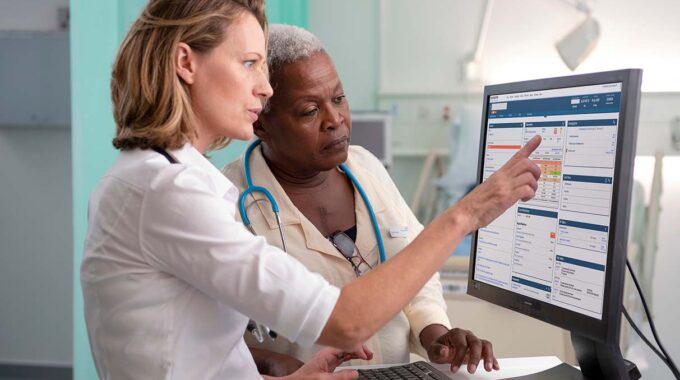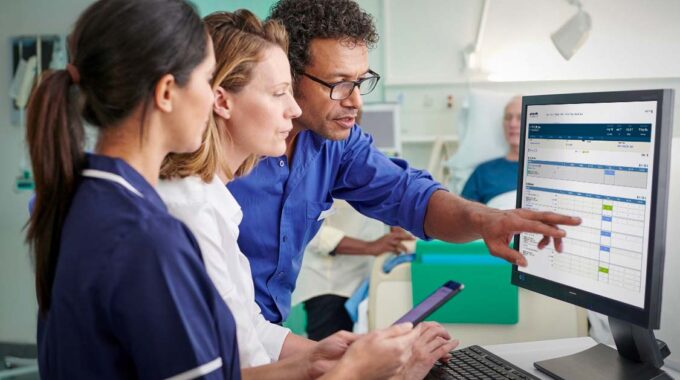University Hospitals of Derby and Burton (UHDB) and Chesterfield Royal Hospital (CRH) have signed a…
New Report from European Commission Highlights Significant Benefits of eHealth Technology from Nervecentre Software and Cisco Cius
New Report from European Commission Highlights Significant Benefits of eHealth Technology from Nervecentre Software and Cisco Cius Used to Manage ‘Out Of Hours’ Care at one of Europe’s Largest Hospitals
ACCA Study: New collaboration technology delivers cash savings of £97,000 per year; estimated £292,000 per year of avoided costs by releasing nurses from administrative functions, avoided costs in extended lengths of stay; improved patient safety and increased staff satisfaction
LONDON, 19 May 2011; According to a study commissioned by the European Commission, technologies such as wireless networks, tablet computers and portable phone handsets can speed up the treatment of patients, improve communication between medical and nursing staff and make medical and procedural information more easily available to junior doctors in hospitals.
The study by the Association of Chartered Certified Accountants (ACCA) assessed the impact of introducing new collaboration technology from Cisco and Nervecentre at Nottingham University Hospitals NHS Trust (NUH). The report reveals a significant improvement in patient safety, operational efficiency and clinical governance in NUH’s out-of-hours ‘Hospital at Night’ (H@N) Emergency Department service.
The new hospital systems includes a Cisco medical-grade network to provide both wired and wireless (Wi-Fi) network access; a real-time workforce management system from Nervecentre; and 11 Cisco Cius™ tablets, mobile collaboration tablets built for business, for use by each H@N co-ordinator at NUH.
Highlights:
According to the ACCA report, benefits delivered through the use of these technologies include:
Further significant benefits that have already been seen by NUH include:
The results and benefits are published as part of a study conducted by the ACCA into the impact of ICT in healthcare delivery systems, ‘Collaboration and communication technology at the heart of good clinical governance’. The study follows a previous assessment of the use of wireless telephony and messaging in the NUH Emergency Department.
Key Facts:
The Challenge
The Solution
Supporting Quotes:
“The old system of H@N administration was complex and inefficient, raising questions of safety and had poor levels of staff satisfaction. The H@N coordinators are now able to spend around 60 per cent of their shift providing direct clinical care on the wards, compared to at best three per cent before. The investigation team showed that while previously H@N coordinators had spent under four hours per week on clinical work, using the new system they were able to spend over 75 hours per week on direct hands-on care.”
“Working with Cisco and Nervecentre we have been able to introduce a system that removes unnecessary complexity and from which NUH will reap direct financial and operational benefits, as well as being able to help patients get more timely care. These results show that collaborative processes, supported by networked communications and collaboration, can deliver significant improvements in performance in the areas of quality and productivity – aligning with the overall NHS Quality, Innovation, Productivity and Prevention (QIPP) Programme aims and objectives.”
“At a time when cost and efficiency are the two priorities for our healthcare system, effective communication has become increasingly important in ensuring NHS staff can do their jobs efficiently. From the outset this project has been all about better collaboration between ward staff, nursing staff and medical staff. As a result, NUH has been able to reap the rewards within just four months, leading to better clinical governance, information governance and planning.”
“With £20 billion of savings to deliver by 2014, it is vital that NHS Trusts have proven blueprints that help them to deliver against this target. I’m delighted that this report provides hard evidence of significant savings and improvements in patient safety delivered by the project. I’m also particularly pleased that the staff survey shows an increase in staff satisfaction from around 60 per cent to 90 per cent. Staff adoption is the cornerstone of any successful IT project and we placed a high priority on ensuring the technology was easy to use and addressed the frustrations of clinical staff.”
Supporting Materials:
ENDS
Notes to Editors
About Cisco
Cisco and the Cisco logo are trademarks or registered trademarks of Cisco and/or its affiliates in the U.S. and other countries. A listing of Cisco’s trademarks can be found at www.cisco.com/go/trademarks. Third-party trademarks mentioned are the property of their respective owners. The use of the word partner does not imply a partnership relationship between Cisco and any other company.
# # #
About Nottingham University Hospitals NHS Trust
Nottingham University Hospitals NHS Trust (NUH) is one of the largest acute teaching trusts in the country. It is made up of Queen’s Medical Centre (QMC), Nottingham City Hospital and Ropewalk House, a facility in Nottingham City Centre where hearing services are based.
The Trust provides acute and specialist services to 2.5 million people within Nottingham and surrounding communities from QMC, City Hospital campuses and Ropewalk House.
NUH has an annual budget of £722million of public sector funding and employs over 13,000 staff, making the Trust one of the city’s biggest employers. In addition, NUH has over 1,500 volunteers who each make a unique contribution to NUH. The Trust currently has around 1,700 beds and 87 wards.
About the ACCA
About Nervecentre
Nervecentre Software is a healthcare focused consultancy and software development organisation founded in 2010 which is committed to enabling the NHS to improve productivity and quality through innovative collaboration technology. Nervecentre is a collaborative workforce management system that addresses patient safety, clinical governance and resource management. The application is platform independent and integrates into a hospitals’ existing IT system as well as any Cisco wireless and telephony infrastructure.




This Post Has 0 Comments